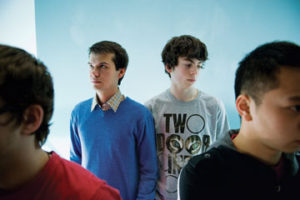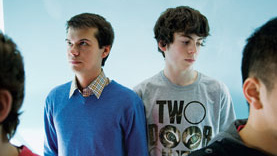Carly Centen
Contributor
You’re in a pub, and you’ve just met an attractive, interesting new person you’d like to get to know better.
The conversation is engaging, but over your partner’s left shoulder a television is showing the hockey game, and your favourite song has just come on. Still, you know that if your attention wanders you will appear uninterested in the discussion at hand.
Researchers at York have been investigating what it is about the brain exactly that allows us to take in all these different stimuli in our environment but remain able to sup- press our automatic impulse to respond to some of them. If we were not able to do so, we would never accomplish anything.

In a study published recently in Frontiers in Human Neuroscience, graduate student and lead author Shima Ovaysikia used functional Magnetic Resonance Imaging (fMRI) to determine what part of the brain is responsible for processing automatic and controlled processes when these processes conflict or interfere with one another.
Researchers conducted the study in con- junction with the Centre for Vision Research at York, and presented participants with an image of a face with a happy, neutral or sad expression that was superimposed with text that either matched or contradicted the emotion of the face.
The participants were then asked to either identify the emotion of the word with disregard for the facial expression, or to identify the expression without attending to the word.
This experimental design was modeled after the traditional Stroop test, where individuals are asked to identify coloured words that do not match the colour the text describes – for example, the word “yellow” in blue ink. Identifying emotions added a new dimension to the classic test due to the presumed innate nature of facial recognition, allowing researchers to test much more complex stimuli.
Participants were able to process the written words faster than the facial expressions, which surprised the researchers. “We thought that facial recognition would be recognized faster because it is a more innate skill than reading, which is learned,” says Ovaysikia, who conducted the experiment under the supervision of Joseph DeSouza, assistant professor of psychology in York’s faculty of health.
When the word superimposed on the face was incongruous – that is, an image of someone frowning with the word “happy” written across it – reaction time increased.|
“The emotion in the word doesn’t match the emotion in the facial expression, which creates a conflict,” says professor DeSouza.
“Our study showed ? for the first time ? an increase in signal from the left inferior frontal cortex when the study participant was confronted by this conflict between the word and the image and asked to respond to directions that went against their automatic instincts.”
The prefrontal cortex is associated with higher order cognitive functions related to behaviour, like long-term planning, decision-making, emotions and inhibition. It is the area of the brain that oversees the coordination of thoughts and actions in order to achieve goals.
Pinpointing the region of the brain responsible for regulating such behaviour might have implications for people show- ing problems with inhibition, such as those with damage to their prefrontal cortex due to a stroke or brain trauma, as well as people with schizophrenia.
Another possible area of application is in studying the impulse and suppression involved in a behaviour like gambling, an area where Ovaysikia intends to direct her future research.
The results also help to explain what is going on in our brains when two simultaneously competing processes would lead to different behavioural outcomes.
“One of the most important things that makes us human is that we don’t just always react to stimuli because we can suppress our urge to act,” says DeSouza. Imagine that a cell phone rings in a classroom, he explains. Most students will turn in the direction of the ring, but some will hold their attention on something else, resisting the distraction. “Our brains have evolved to suppress these natural things that enter our environment,” concludes DeSouza, “or we would spend all of our time reacting.”
Why we won’t look at each other


